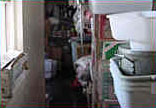Our Services
Deodorization & Odor Removal
 |
 |
California Emergency Services relies on a number of different deodorization methods depending on the odor, the severity of the odor and the source of the odor.
Thermal fogging is a common method of deodorization used to dissolve the odor-producing impurities deposited by smoke and other odor-producing elements. It is an excellent deodorization method for minor odors such as light smoke or a light pet odor.
Thermal foggers rely on a deodorizing chemical that is vaporized in the fogger then blown into the room permeating all of the contents and structural elements. The vaporized chemical will actually pair with the odor molecules to absorb them and rid the premise of the smell. This process is quite effective when combined with necessary cleaning.
Ozone deodorization is extremely effective for more serious odor. This is the primary method for clothing, upholstered items, papers, books or any other porous material affected with an odor. Ozone is produced by a machine into an airtight chamber where all items needing deodorization have been placed. The machine takes oxygen out of the air (O2), charges it electrically and turns it into (O3) Ozone. Ozone is highly reactive and combines with malodor molecules to chemically alter their structure and rid property of odor.
Because ozone has the ability to penetrate into fabrics and surfaces to the same extent that the malodor did, it is the most effective means of long-range deodorization and it is permanent. There is no residual odor from the process itself and no damage to the property. Ozone also kills bacteria and fungi and works as a sanitizing agent. It is a permanent method - once an item is deodorized, the odor cannot and will not return.
Another method of deodorization involves utilizing an Air Filterization Device (AFD). This machine relies on three filters to purify and deodorize the air. With the AFD and the filters it will remove 99.9% of odor causing molecules. The first filter removes large particles up to 10 microns and larger. The second filter removes particles up to 1 micron and larger and the third or HEPA filter removes the smaller size fibers from the air. All processed air is vented to an outside source and the air in a building is "scrubbed" clean. This machine is also commonly known as an air scrubber and can be used as a negative air machine.
The Institute of Inspection Cleaning & Restoration Certification (IICRC) certifies California Emergency Services in the area of Odor Control.
Fire • Smoke • Odor • Water • Mold • Specialty Services
Licensed & Certified • Residential & Commercial • Bonded & Insured • 24-Hour Emergency Service
